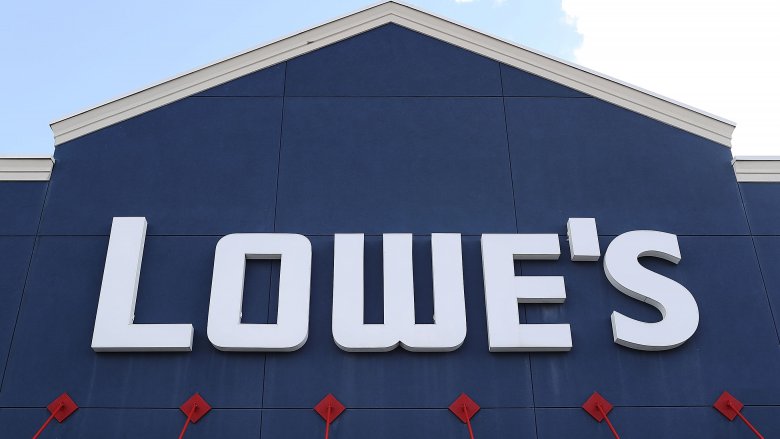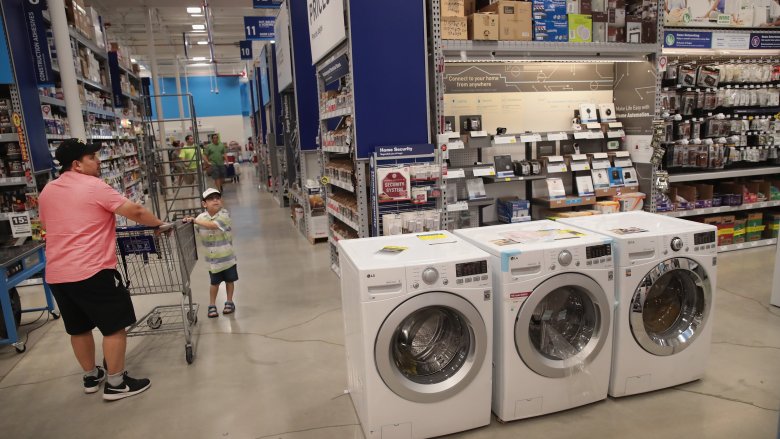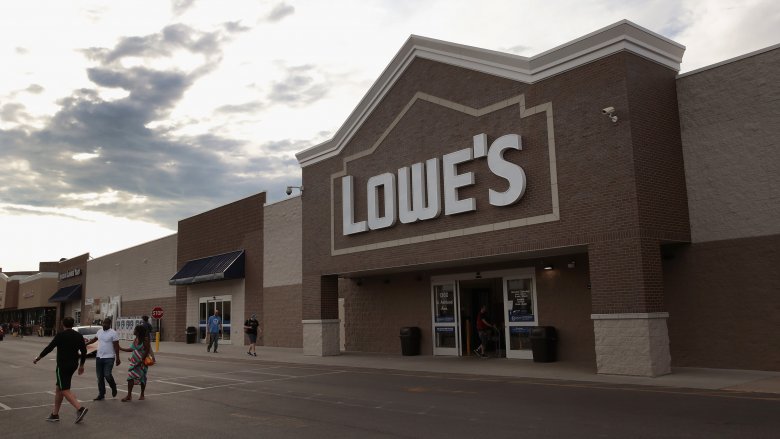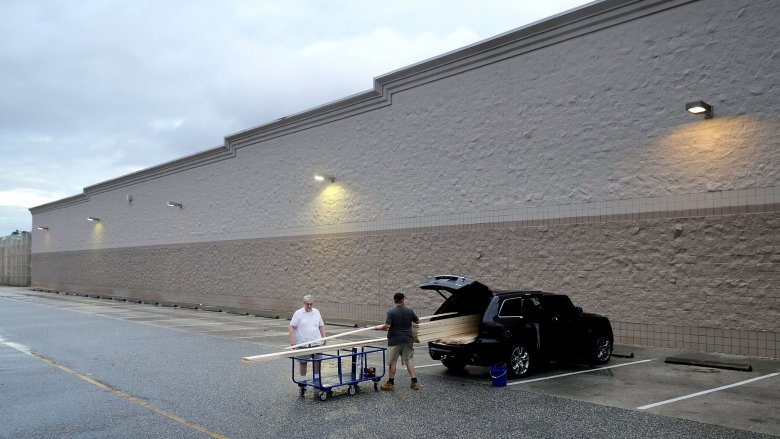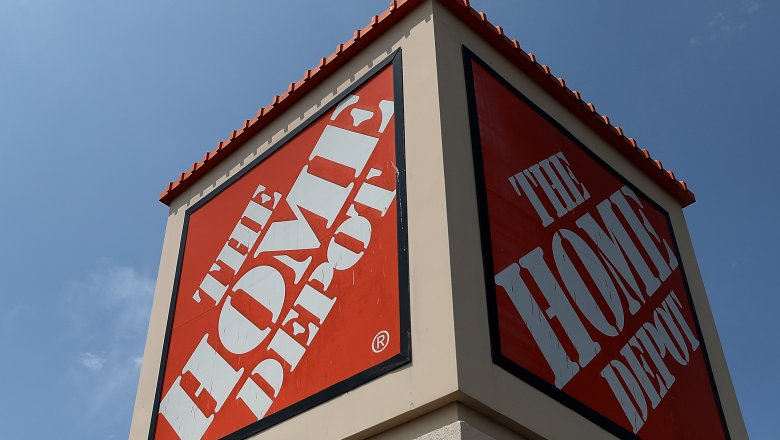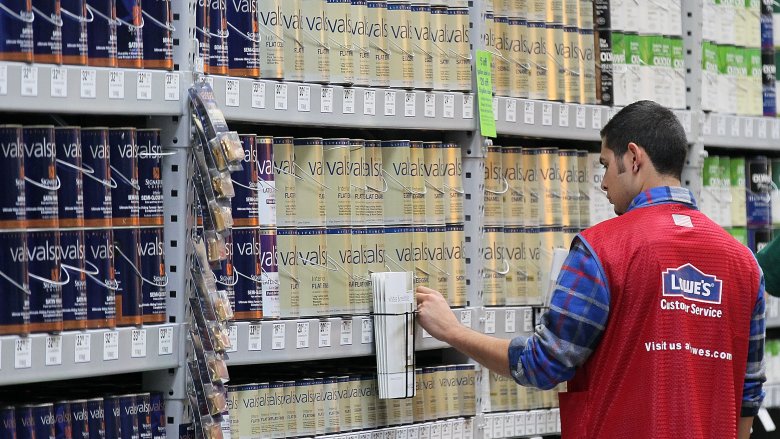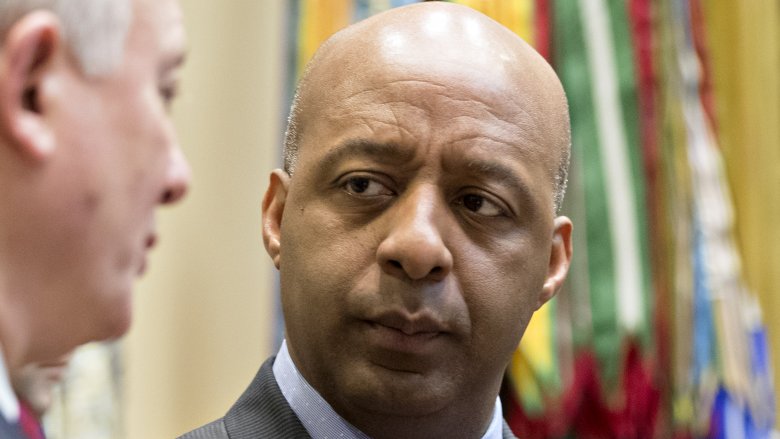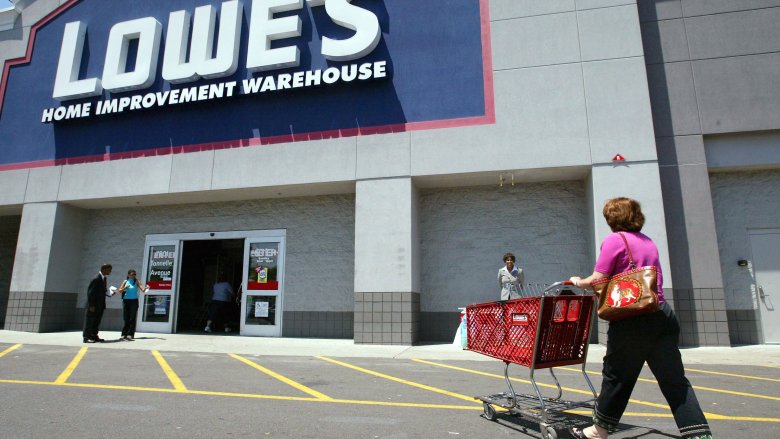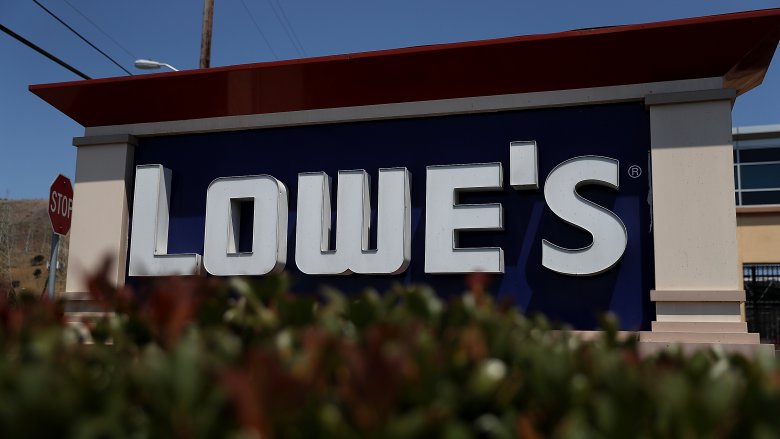The Real Reason Lowe's Stores Are Disappearing
Many people in the U.S. and Canada are going to have to find a new place to buy paint, hammers, lumber, lawnmowers, and aimlessly roam the aisles on a Saturday afternoon. Lowe's, the eighth-biggest retail chain in the U.S., and 19th-largest in the world, announced on November 5, 2018, that it's closing a number of its stores. The retail climate is a tough one, and it always has been, but Lowe's toughed it out, growing from a quaint hardware store in North Carolina in the 1940s into the planet's second-largest chain that sells tools, plumbing fixtures, and other materials for do-it-yourself home improvement and repair projects.
Here are a few of the reasons Lowe's had to raise the proverbial white flag and make the bold decision to shut down some locations.
Certain stores didn't meet certain goals
When some retail chains announce store closings, they really just make it known that they'll be closing an indeterminate number of not-yet-chosen locations in the near future. That's not what Lowe's did. With this announcement, the company stated exactly how many stores it would shutter and exactly which ones they were. In total, Lowe's will close 47 branches — 20 in the United States and 27 up in Canada.
The specific locations are rather scattershot, spread across 13 states and five Canadian provinces. The soon-to-be-dead stores are all over the place, so Lowe's isn't necessarily pulling out of specific markets or regions altogether, choosing instead to shut down specific stores that it has identified as underperforming. By doing that, according to a company statement, Lowe's can "focus on its most profitable stores and improve the overall health of its store portfolio." Marvin Ellison, Lowe's CEO and president, added, "The store closures are a necessary step in our strategic reassessment as we focus on building a stronger business."
They were a victim of their own success
According to Lowe's, the shuttering stores turn in lackluster sales figures, but that might be because they're getting run out of business by the competition. Specifically, and ironically, many of those circling sharks are actually just other Lowe's branches. "The majority of impacted stores are located within 10 miles of another Lowe's store," the company said in a press release. In other words, the ones on the chopping block are redundant.
So it's a bad news/good news situation, at least for the Lowe's employees. Because there's another Lowe's around the corner in most cases, the company promises that "most associates at these stores will be extended opportunities to transition to a similar role at a nearby Lowe's store." Same job, different commute.
Will more Lowe's locations shut down?
While closing 47 stores is all the shutdowns Lowe's has in store for right now, that doesn't necessarily mean that this is the end of the hardware chain's selective culling. Earlier in 2018, Lowe's started a gradual close-down of Orchard Supply Hardware, the mostly West Coast-based series of 99 stores it acquired from Sears in 2013. (At the time, Lowe's CEO Marvin Ellison called it "a necessary business decision" to cut and run.) According to Barron's, shutting down large numbers of stores at any one time is a crucial part of "Lowe's new strategy" to hold its own in the highly competitive retail world. That could feasibly mean Lowe's shuts down more stores in the coming months and years ... should it need to do that. You never can tell what the future will bring, but if you're noticing that your favorite Lowe's location is just never busy, maybe start preparing yourself.
Big moves means big results
Immediately after Lowe's announced those closures, the company's stock, ironically trading as LOW, saw its value trend higher. According to stock and financial analysts, getting rid of not-great stores was a savvy move for the company because it can reallocate some of its funds into stores that turn more profit, thus theoretically leading to even more profits. In the days after the 47 stores got their closure notices, Lowe's stock was valued at around $100, and analyst Jordan Matuszewski of Jeffries said a $126 stock price was within reach. He said the closures are "symbolic of the upgraded leadership team examining all root causes of underperformance and a renewed sense of urgency." Thanks to the aggressive approach by the new CEO and other executives, Lowe's stock was up more than 4 percent year-to-date following the announcement, which put it in front of Home Depot. (And really, isn't that what it's all about?)
Lowe's isn't Home Depot
As in most other industries, there's a two-horse rivalry in the big-box chain hardware/home improvement industry fighting for customers, retail space, and business: Home Depot and Lowe's. And while most stores that sell the exact same stuff can comfortably coexist for decades (McDonald's vs. Burger King, for example), something's got to give now and then, or, like Highlanders, there can only be one (market leader). Right now, the #1 spot in hardware is solidly occupied by Home Depot, and Lowe's is struggling to keep pace. According to CNBC, Home Depot not only does better business than the relatively lowly Lowe's, but it also controls better retail real estate and has a more robust e-commerce fulfillment sector. Home Depot is more available and more attractive, which hurts Lowe's.
Retail is dying
The American retail landscape isn't what it used to be, for better or for worse. The economy is robust, and most everything is available at a decent price to anyone who wants it at any time, but it's harder and harder to find items at Main Street shops or even at the big-box stores that slowly replaced those Main Street shops. Online ordering makes buying things very quick and easy, and the convenience of Amazon and other mail-order suppliers has directly led to what economic experts have dubbed the Retail Apocalypse. Unlike online stores, traditional, brick-and-mortar stores have to spend through the nose on things like storefronts and people to work the cash registers. That all eats into already dwindling profits. The closure of a sizable chunk of Lowe's stores is but another example of the Retail Apocalypse in action. Among the other high-profile retail bankruptcies and big store closures since 2015: Sears, Claire's, Toys "R" Us, Gymboree, Payless Shoes, RadioShack, Sports Authority, Macy's, and Wet Seal.
There's a new guy in charge
Usually when a humongous retail chain closes a bunch of stores all at once, it's an instantly millions-saving, metaphorical swing for the fences move by an aggressive executive looking to staunch a cashflow wound as quickly as possible. That, or it's the action of a new mucky-muck coming in and acting quickly and spectacularly to make their presence felt (and to also, you know, save the company). In the case of Lowe's, it seems like both.
In May 2018, Lowe's announced it had hired a new CEO and president: Marvin Ellison, taking the leadership role from the retiring Robert A. Niblock. Ellison's previous post before hitting Lowe's? Desperately trying to save J.C. Penney as its chairman and CEO. Before that, he worked at Home Depot's front office for more than a decade, including a stint as the executive vice president of American stores. Scarcely six months after taking the job, Ellison cleaned house(s) — 47 of them to be exact.
The closures can be used to eke out a bit more money
One doesn't really think of Lowe's as a place to buy gifts for their loved ones, but the retail industry as a whole experiences such a big infusion of cash that even big-box hardware stores benefit. (Plus, lots of people really would love to see a new power drill or toolbox under the Christmas tree.) Perhaps anticipating those holiday crowds, Lowe's won't close most of the 47 stores marked for death until after "The Most Wonderful Time of the Year" is over. Lowe's fiscal year ends on February 1, 2019, by which time all 47 will be closed. To that end, the corporate office has enlisted the help of Hilco Merchant Services, a retail liquidation company that goes into stores and clears out as much merchandise as quickly as possible.
Of course, these kinds of corporate decisions are never personal — they're about business, meaning money. Cutting dead weight will theoretically make Lowe's more profitable and more valuable. The company believes that the move will add 28 to 34 cents of value per share of stock, boosting the company's overall worth by as much as $274.8 million.
They could have closed more if necessary
While the closure of 47 Lowe's locations is a lot — and it's certainly a notable life event to the hundreds of people who work at those stores — in the grand scheme of things, it's really just a tiny percentage of Lowe's outlets overall. In North America, the company operates about 2,100 stores — 1,800 in the United States and 300 in Canada. That means only 2 percent of Lowe's branches are shutting down. Clearly, the store's executives spent some time cherry-picking exactly which stores were the ones that needed to go and didn't close any more than they absolutely had to. If the company was in more severe financial straits, it logically would have closed far more locations than it ultimately did.
